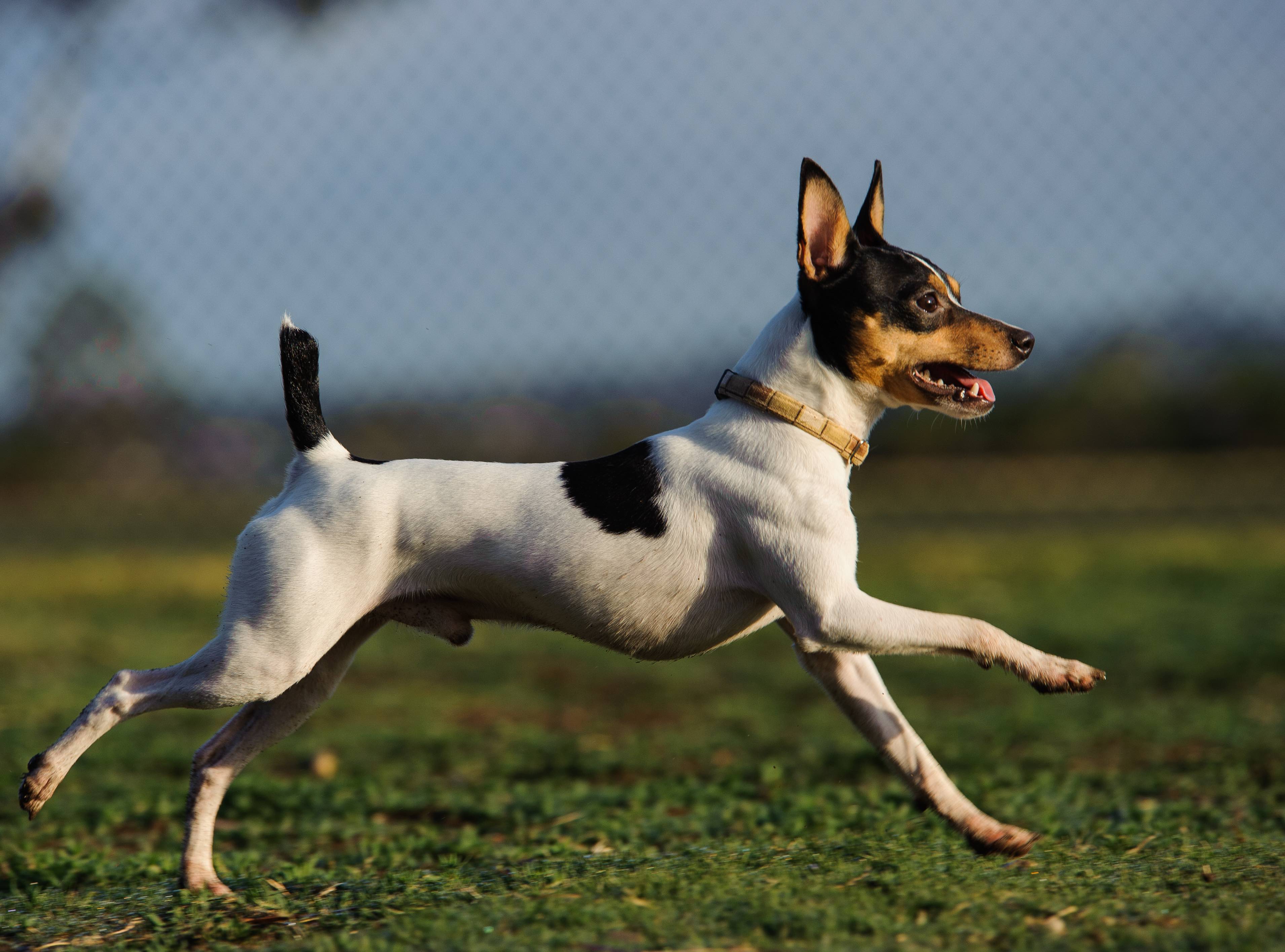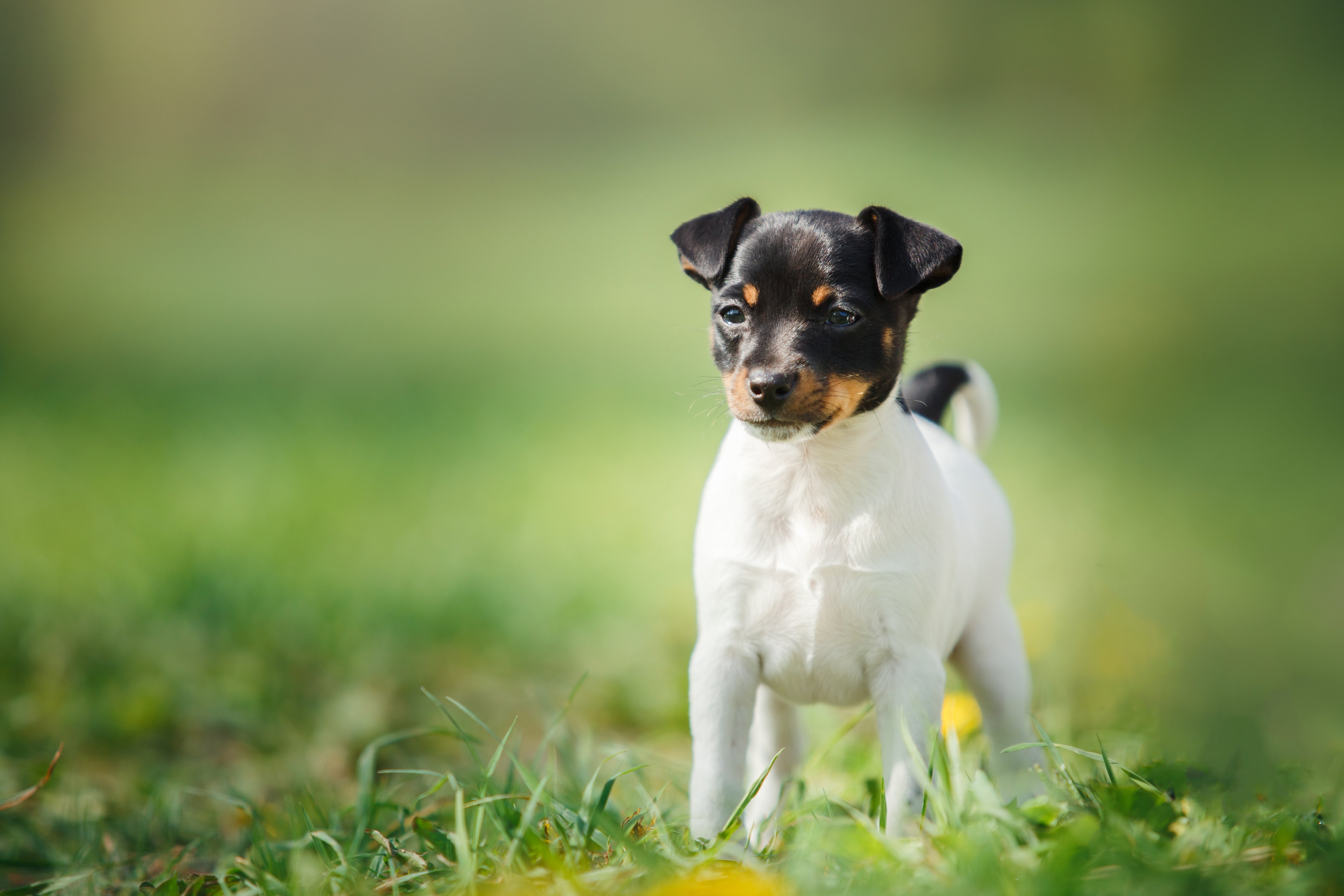Toy Fox Terrier
Adobe Stock/Vincent
The Toy Fox Terrier is a little yet lively breed with a rich history. This small dog breed originated in England and is a direct descendant of the larger Smooth Fox Terrier. According to the National Toy Fox Terrier Association (NTFTA), breeders developed smaller versions of the Smooth Fox Terrier in the mid-1920s.
Toy Fox Terriers are pint-size powerhouses weighing 4–9 pounds and standing 8.5–11.5 inches tall. Their sleek coat is short and smooth, often featuring a predominantly white color with striking patches of black and tan. Despite their tiny size, these dogs are agile, making them skilled at various dog sports.
Beyond their vivacious personality, Toy Fox Terrier pups are cherished for their loyalty and make excellent companions for active individuals and families seeking a small yet mighty canine friend.
Caring for a Toy Fox Terrier
Despite their small size, Toy Fox Terriers are known for their confidence and big personality. They have an affectionate temperament and form a strong bond with their pet parents. This dog is a typically loyal and devoted companion when trained and socialized from an early age.
As a pet parent, you should expect a high energy level from your Toy Fox Terrier. These little dogs are always up for playtime and activities, so regular exercise—at least an hour every day—is crucial to prevent boredom and help positively channel their energy. Implementing interactive toys and engaging games into their daily routines can also help keep them mentally stimulated.
Toy Fox Terrier Health Issues
The average lifespan of a Toy Fox Terrier is 13–15 years, and they’re known to be a generally healthy breed. However, like any dog, they may be predisposed to certain health conditions.
Patellar Luxation
Patellar luxation is a common orthopedic issue in Toy Fox Terriers. This condition happens when the kneecap slips out of its normal position and can cause limping/lameness or kicking hindlegs to the back in an effort to put the kneecap back in place. Mild cases may not require treatment, but severe instances may necessitate surgical correction. Regular veterinary checkups can help monitor and manage this condition.
Legg-Calve-Perthes Disease
Typically found in smaller dog breeds, Legg-Calve-Perthes disease arises from the degeneration of the femoral head (top of the femur bone), leading to a reduction in blood supply. Treatment often involves surgical intervention followed by physical therapy for rehabilitation. Early detection with an X-ray and intervention are crucial for prevention and treatment.
Demodectic Mange
Demodectic mange is a skin condition resulting from an infestation of microscopic parasitic mites.
All dogs naturally harbor demodectic mites in small quantities within their hair follicles. However, in some dogs—usually those that are young, old, or immune-compromised—these mites can multiply, leading to a significant population on the hair and skin that causes a moth-eaten appearance. Contact your veterinarian if you notice changes in your dog’s skin, including flakiness, hair loss, and thickening of the skin.
Von Willebrand Disease (vWD)
Toy Fox Terriers are prone to von Willebrand Disease (vWD), a condition that affects a dog’s blood clotting. This means that injuries and surgeries can be dangerous to an affected Toy Fox Terrier, as they won’t be able to stop bleeding normally.
vWD can be diagnosed through a blood test, and responsible breeders won’t produce Toy Fox Terrier puppies from affected parents.
What To Feed a Toy Fox Terrier

Choosing the right dog food for your Toy Fox Terrier is essential to ensure their overall health. This involves considering their small size, high energy level, and specific nutritional requirements.
Look for dog foods with high-quality protein sources that meet the nutritional requirements set by the Association of American Feed Control Officials (AAFCO). Your veterinarian can help you find the best food based on your dog’s life stage (puppy, adult, or senior).
How To Feed a Toy Fox Terrier
Tailoring the feeding process for your Toy Fox Terrier is essential. Consider variables like their small size, age, energy level, and individual health. Small breeds like Toy Fox Terriers may benefit from more frequent, smaller meals to maintain energy levels throughout the day and help with digestion.
If you can, establish a consistent feeding schedule, ensuring your dog eats at the same time each day with the proper portions to avoid overeating, as Toy Fox Terriers are prone to obesity.
How Much Should You Feed a Toy Fox Terrier?
How much you feed your Toy Fox Terrier depends on your dog’s size, age, health, and lifestyle. Your AAFCO-approved dog food will contain a chart on portion guidelines, but working with your veterinarian will give you the best guidance on how much your dog should eat every day.
As a general rule, feed your Toy Fox Terrier puppy three to four times every day. Adult dogs can eat two to three times a day.
Nutritional Tips for Toy Fox Terriers
Toy Fox Terriers that eat an AAFCO-compliant dog food receive all the nutrients they need. However, your veterinarian might recommend a dog supplement, depending on your pet’s health, such as:
-
Omega-3 fatty acids (fish oil)
-
Multivitamins
Always consult with your veterinarian before introducing supplements to your dog’s diet.
Behavior and Training Tips for Toy Fox Terriers
Toy Fox Terrier Personality and Temperament
While every dog is an individual, the typical Toy Fox Terrier temperament is spirited and affectionate. They form strong bonds with their pet parents and, when socialized and trained, can be good playmates for children who know how to interact with small dogs.
These small dogs exhibit high energy levels, requiring regular exercise and mental stimulation. They thrive when engaged in activities that challenge their mind.
Toy Fox Terrier Behavior
Naturally alert and curious, Toy Fox Terriers have a keen sense of awareness and may be quick to investigate their surroundings. Like many terrier breeds, Toy Fox Terriers were historically used as hunters and still maintain a strong prey drive today, according to the NTFTA.
This means they may be prone to barking at and chasing smaller animals. Early and consistent training can help manage excessive barking, and pet parents must keep these pups on a leash or inside a fenced yard whenever their dog is outside.
Naturally alert and curious, Toy Fox Terriers have a keen sense of awareness and may be quick to investigate their surroundings.
Toy Fox Terrier Training
As a smart dog, Toy Fox Terriers can learn cues quickly. But because they were bred to be independent workers, they may lose interest in training sessions that are too long and boring to them. Keep training lessons short and fun, and always use positive reinforcement, such as treats, praise, and play, to motivate them to focus.
Fun Activities for Toy Fox Terriers
-
Clicker training
-
Nose work
-
Fetch
-
Obedience training
-
Playdates with other small dogs
Toy Fox Terrier Grooming Guide
Toy Fox Terrier dogs are relatively low-maintenance when it comes to grooming.
Skin Care
Toy Fox Terriers don’t have specific skin care needs. Talk to your veterinarian about how often you should bathe your dog, and which flea and tick prevention you should be using. Be alert for changes in your dog’s skin, and consult your vet if you notice redness, flakiness, hair loss, etc.
Coat Care
Toy Fox Terrier dogs have a short and smooth coat that doesn’t shed a lot or become tangled. It's helpful to brush their coat once or twice a week to minimize what shedding does occur and keep their coat healthy.
Eye Care
This breed has bright, round eyes that are not prone to severe problems seen in some other dogs. But pet parents should still pay attention to their dog’s eyes and talk to their veterinarian if they notice changes.
If your Toy Fox Terrier develops tear stains, wipe them away with a dog-safe eye wipe.
Ear Care
Because Toy Fox Terriers have ears that stand upright, they are not as prone to ear infections as breeds with folded, floppy ears. But all dogs can develop ear infections, so check your pup’s ears regularly for redness, swelling, discharge, or odor in their ear canal.
Ask your veterinarian how often you should clean your dog’s ears, and always use veterinary-recommended ear-cleaning products.
Considerations for Pet Parents

Prospective Toy Fox Terrier pet parents should prepare for a loyal, loving companion with a high energy level. The ideal home for this breed has time to exercise their dog’s body and mind throughout the day, while providing lots of attention and love. Toy Fox Terriers do well in homes with individuals or families.
Toy Fox Terrier FAQs
Are Toy Fox Terriers good pets?
Yes, Toy Fox Terriers can make wonderful pets for the right families or individuals. But pet parents must dedicate time to keeping this breed active.
How big will a Toy Fox Terrier get?
The Toy Fox Terrier is a small dog that usually stands 8.5–11.5 inches tall and weighs 4–9 pounds.
Is a Toy Fox Terrier a Chihuahua?
No, a Toy Fox Terrier is not a Chihuahua. While both are small breeds, they have unique breed standards, temperaments, and physical characteristics that set them apart.
What’s the difference between Toy Fox Terriers and Rat Terriers?
Toy Fox Terriers and Rat Terriers are both small terrier breeds with short and smooth coats, but they do have notable differences. Rat Terriers are larger than Toy Fox Terriers, standing 10–18 inches tall and weighing 10–25 pounds.
Do Toy Fox Terriers like to cuddle?
Yes, Toy Fox Terriers are known for their affectionate nature, and many of this breed enjoy cuddling with their pet parents—as long as their exercise needs are met first.
